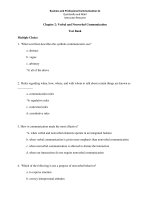Lecture Business and administrative communication: Chapter 8 - Kitty O. Locker, Donna S. Kienzler
Bạn đang xem bản rút gọn của tài liệu. Xem và tải ngay bản đầy đủ của tài liệu tại đây (631.31 KB, 20 trang )
Chapter 8
Working and
Writing in Teams
Copyright © 2015 McGrawHill Education. All rights reserved. No reproduction or distribution without the prior written consent of McGrawHill Education.
Team Interactions: Three Dimensions
Informational—focus on content:
problem, data, solutions
Procedural—focus on methods,
processes
Interpersonal—focus on people,
cooperation, team loyalty
82
Team Interactions, continued…
Formation
Begin to define task
Develop social
cohesiveness
Set up and clarify
procedures
Adopt ground rules
Use interpersonal
communication to
resolve tensions
Analyze problem
well before seeking
solutions
Coordination
Longest phase
Most comments
informational
Conflict as team
debates alternate
solutions
Interpersonal and
procedural
comments help
team stay on track
Consider many
solutions
Formalization
Consensus state
Team implements
decisions, which
determines its
success
Team seeks to
forget earlier conflicts
83
Positive Actions in Teams
Encouraging participation
Relieving tensions
Checking feelings
Solving interpersonal problems
Listening actively
84
Negative Actions in Teams
Blocking
Dominating
Clowning
Overspeaking
Withdrawing
85
Team Leadership
Effective teams balance three types of
leadership:
Informational—create, assess ideas and text
Interpersonal—check feelings, resolve conflict,
monitor process
Procedural—set agenda, keep members
informed, check on assignments
Roles need not be filled by one person
86
DecisionMaking: Problem Solving
87
DecisionMaking: Dot Planning
Lets large team set priorities quickly
Team brainstorms ideas
Ideas recorded on large pages
Pages posted on wall
Each member affixes colored adhesive dots
by ideas
High
Low
Dots
show highest and
lowest priorities
88
Feedback Strategies
Generate and heed as much feedback as
possible
Seek external—supervisors, suppliers,
clients, customers
Seek internal—within in the team
89
Successful Student Teams
810
Peer Pressure and Groupthink
Groupthink—tendency for teams to
value agreement so highly they punish
dissent
Correctives to groupthink
Search for alternatives
Test assumptions
Protect rights of individuals to disagree
811
Diverse Teams
Differences affect how people behave in
team, what they expect from team
Play to one another’s strengths
Find practical ways to deal with
differences
812
Conflict Resolution
1.
2.
3.
4.
5.
Make sure people involved really
disagree
Ensure that everyone has correct
information
Discover needs each person is trying to
blem
o
r
p
meet
g
sentin
m
e
r
p
e
proble
l
Th
a
e
r
t be
o
n
y
a
m
Search for alternatives
Repair negative feelings
813
Criticism Responses
Paraphrasing
Checking for feelings
Checking inferences
Buying time with limited agreement
Using you-attitude
Look at things from others’ viewpoint I
statements are effective
814
Effective Meeting Guidelines
Make purpose explicit
Distribute an agenda
Allow time for discussion
Save time with an omnibus motion
Pay attention to people and process as well as
tasks
Summarize group’s consensus after each point
Summarize all decisions at end of meeting
815
Technology in Teams
Meetings
Scheduling
Skype, FaceTime, Google+
GoToMeeting
Online calendars
Project management
Collaboration
816
Collaborative Writing
Working with other writers to produce a
single document
Requires attention to
Team formation process
Conflict resolution
Steps in writing process
817
Collaborative Writing, continued…
Planning
Make analysis explicit; know where you agree and disagree
Plan organization, format, and style before anyone writes
Consider work styles and other commitments
Decide how you will give feedback
Build leeway into deadlines
Composing
Decide who will write what
Decide how to share drafts
Label and date drafts
If quality is crucial, have best writer compose after others
gather data
818
Collaborative Writing, continued…
Revising
Evaluate content, discuss revisions as team
Evaluate organization, discuss revisions
Recognize that different people favor different writing styles
When satisfied with content, have best writer make all changes
to writing style
Editing and Proofreading
One person checks mechanics, format, and style for
correctness, consistency
Use a spell checker
Proofread document also
819
Making the Team Process Work
820









